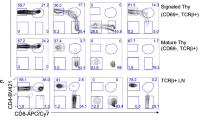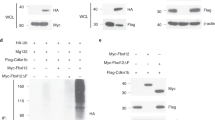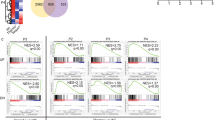Abstract
At critical times in development, cells are able to convert graded signals into discrete developmental outcomes; however, the mechanisms involved are poorly understood. During thymocyte development, cell fate is determined by signals originating from the αβ T-cell receptor. Low-affinity/avidity interactions between the T-cell receptor and peptide–MHC complexes direct differentiation to the single-positive stage (positive selection), whereas high-affinity/avidity interactions induce death by apoptosis (negative selection)1,2. Here we show that mice deficient in both calcineurin and nuclear factor of activated T cells (NFAT)c2/c3 lack a population of preselection thymocytes with enhanced ability to activate the mitogen-activated protein kinase (Raf–MEK–ERK) pathway, and fail to undergo positive selection. This defect can be partially rescued with constitutively active Raf, indicating that calcineurin controls MAPK signalling. Analysis of mice deficient in both Bim (which is required for negative selection) and calcineurin revealed that calcineurin-induced ERK (extracellular signal-regulated kinase) sensitization is required for differentiation in response to ‘weak’ positive selecting signals but not in response to ‘strong’ negative selecting signals (which normally induce apoptosis). These results indicate that early calcineurin/NFAT signalling produces a developmental period of ERK hypersensitivity, allowing very weak signals to induce positive selection. This mechanism might be generally useful in the discrimination of graded signals that induce different cell fates.
This is a preview of subscription content, access via your institution
Access options
Subscribe to this journal
Receive 51 print issues and online access
$199.00 per year
only $3.90 per issue
Buy this article
- Purchase on Springer Link
- Instant access to full article PDF
Prices may be subject to local taxes which are calculated during checkout




Similar content being viewed by others
References
Palmer, E. Negative selection–clearing out the bad apples from the T-cell repertoire. Nature Rev. Immunol. 3, 383–391 (2003)
Starr, T. K., Jameson, S. C. & Hogquist, K. A. Positive and negative selection of T cells. Annu. Rev. Immunol. 21, 139–176 (2003)
Neilson, J. R., Winslow, M. M., Hur, E. M. & Crabtree, G. R. Calcineurin B1 is essential for positive but not negative selection during thymocyte development. Immunity 20, 255–266 (2004)
Cante-Barrett, K., Winslow, M. M. & Crabtree, G. R. Selective role of NFATc3 in positive selection of thymocytes. J. Immunol. 179, 103–110 (2007)
Alberola-Ila, J., Forbush, K. A., Seger, R., Krebs, E. G. & Perlmutter, R. M. Selective requirement for MAP kinase activation in thymocyte differentiation. Nature 373, 620–623 (1995)
Costello, P. S., Nicolas, R. H., Watanabe, Y., Rosewell, I. & Treisman, R. Ternary complex factor SAP-1 is required for Erk-mediated thymocyte positive selection. Nature Immunol. 5, 289–298 (2004)
Fischer, A. M., Katayama, C. D., Pages, G., Pouyssegur, J. & Hedrick, S. M. The role of erk1 and erk2 in multiple stages of T cell development. Immunity 23, 431–443 (2005)
Shortman, K., Vremec, D. & Egerton, M. The kinetics of T cell antigen receptor expression by subgroups of CD4+8+ thymocytes: delineation of CD4+8+3(2+) thymocytes as post-selection intermediates leading to mature T cells. J. Exp. Med. 173, 323–332 (1991)
Fehling, H. J., Krotkova, A., Saint-Ruf, C. & von Boehmer, H. Crucial role of the pre-T-cell receptor α gene in development of αβ but not γδ T cells. Nature 375, 795–798 (1995)
Levelt, C. N., Carsetti, R. & Eichmann, K. Regulation of thymocyte development through CD3. II. Expression of T cell receptor β CD3 epsilon and maturation to the CD4+8+ stage are highly correlated in individual thymocytes. J. Exp. Med. 178, 1867–1875 (1993)
Penit, C. In vivo thymocyte maturation. BUdR labeling of cycling thymocytes and phenotypic analysis of their progeny support the single lineage model. J. Immunol. 137, 2115–2121 (1986)
Macian, F. et al. Transcriptional mechanisms underlying lymphocyte tolerance. Cell 109, 719–731 (2002)
Gallo, E. M., Cante-Barrett, K. & Crabtree, G. R. Lymphocyte calcium signaling from membrane to nucleus. Nature Immunol. 7, 25–32 (2006)
Iritani, B. M., Alberola-Ila, J., Forbush, K. A. & Perimutter, R. M. Distinct signals mediate maturation and allelic exclusion in lymphocyte progenitors. Immunity 10, 713–722 (1999)
Aliahmad, P. et al. TOX provides a link between calcineurin activation and CD8 lineage commitment. J. Exp. Med. 199, 1089–1099 (2004)
Hogquist, K. A. et al. T cell receptor antagonist peptides induce positive selection. Cell 76, 17–27 (1994)
Hogquist, K. A. et al. Identification of a naturally occurring ligand for thymic positive selection. Immunity 6, 389–399 (1997)
Werlen, G., Hausmann, B. & Palmer, E. A motif in the αβ T-cell receptor controls positive selection by modulating ERK activity. Nature 406, 422–426 (2000)
McNeil, L. K., Starr, T. K. & Hogquist, K. A. A requirement for sustained ERK signaling during thymocyte positive selection in vivo . Proc. Natl Acad. Sci. USA 102, 13574–13579 (2005)
Bouillet, P. et al. BH3-only Bcl-2 family member Bim is required for apoptosis of autoreactive thymocytes. Nature 415, 922–926 (2002)
Kisielow, P., Bluthmann, H., Staerz, U. D., Steinmetz, M. & von Boehmer, H. Tolerance in T-cell-receptor transgenic mice involves deletion of nonmature CD4+8+ thymocytes. Nature 333, 742–746 (1988)
Baldwin, T. A., Sandau, M. M., Jameson, S. C. & Hogquist, K. A. The timing of TCR α expression critically influences T cell development and selection. J. Exp. Med. 202, 111–121 (2005)
Reynolds, L. F. et al. Vav1 transduces T cell receptor signals to the activation of the Ras/ERK pathway via LAT, Sos, and RasGRP1. J. Biol. Chem. 279, 18239–18246 (2004)
Purbhoo, M. A., Irvine, D. J., Huppa, J. B. & Davis, M. M. T cell killing does not require the formation of a stable mature immunological synapse. Nature Immunol. 5, 524–530 (2004)
Cante-Barrett, K., Gallo, E. M., Winslow, M. M. & Crabtree, G. R. Thymocyte negative selection is mediated by protein kinase C- and Ca2+-dependent transcriptional induction of bim of cell death. J. Immunol. 176, 2299–2306 (2006)
Wei, M. L. & Cresswell, P. HLA-A2 molecules in an antigen-processing mutant cell contain signal sequence-derived peptides. Nature 356, 443–446 (1992)
Sturn, A., Quackenbush, J. & Trajanoski, Z. Genesis: cluster analysis of microarray data. Bioinformatics 18, 207–208 (2002)
Xanthoudakis, S. et al. An enhanced immune response in mice lacking the transcription factor NFAT1. Science 272, 892–895 (1996)
Acknowledgements
We thank P. Ebert for helping with calcium flux studies, and K. A. Hogquist and C. Wilson for providing mice and reagents. E.M.G., M.M.W. and A.N.R. were supported by Stanford Graduate Fellowships. M.M.W. was additionally supported by a Howard Hughes Medical Institute predoctoral fellowship. A.N.R. was also supported by a National Science Foundation Graduate Research Fellowship. K.C.B. was supported by the Boehringer Ingelheim Fonds. L.H. was also supported by Agency for Science, Technology and Research Singapore. This work was supported by grants from Howard Hughes Medical Institute and the National Institute of Heath to G.R.C.
Author Contributions E.M.G., M.M.W. and G.R.C. generated the hypotheses, designed the experiments and wrote the manuscript. E.M.G. performed the experiments and generated the figures. K.C.-B. generated the NFATc3 conditional knockout mice, maintained this line in the NFATc2-null background and contributed to the experiments in Fig. 4. A.N.R. and L.H. contributed to pilot experiments and experiments shown in Fig. 2 and Supplementary Fig. 8. J.R.N. generated the Cnb1 conditional knockout mice, conducted pilot experiments and contributed to experimental rationale. L.M. contributed to experiments shown in Supplementary Fig. 5. B.I. provided the Raf-CAAX transgenic mice.
Author information
Authors and Affiliations
Corresponding author
Supplementary information
Supplementary Information
The file contains Supplementary Figures 1-9 and Supplementary Table 1. (PDF 610 kb)
Rights and permissions
About this article
Cite this article
Gallo, E., Winslow, M., Canté-Barrett, K. et al. Calcineurin sets the bandwidth for discrimination of signals during thymocyte development. Nature 450, 731–735 (2007). https://doi.org/10.1038/nature06305
Received:
Accepted:
Published:
Issue Date:
DOI: https://doi.org/10.1038/nature06305
This article is cited by
-
NFAT primes the human RORC locus for RORγt expression in CD4+ T cells
Nature Communications (2019)
-
The ESCRT protein CHMP5 escorts αβ T cells through positive selection
Cellular & Molecular Immunology (2018)
-
Post-translational control of T cell development by the ESCRT protein CHMP5
Nature Immunology (2017)
-
NCoR1 restrains thymic negative selection by repressing Bim expression to spare thymocytes undergoing positive selection
Nature Communications (2017)
-
Tespa1 regulates T cell receptor-induced calcium signals by recruiting inositol 1,4,5-trisphosphate receptors
Nature Communications (2017)
Comments
By submitting a comment you agree to abide by our Terms and Community Guidelines. If you find something abusive or that does not comply with our terms or guidelines please flag it as inappropriate.



